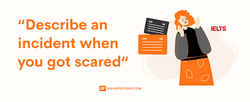Jul 21, 2022
IELTS General Reading : What to do in a fire?


PART 1:
What to do in a fire?
Fire drills are a big part of being safe in school: They prepare you for what you need to do in case of a fire. But what if there was a fire where you live? Would you know what to do? Talking about fires can be scary because no one likes to think about people getting hurt or their things getting burned. But you can feel less worried if you are prepared.
It's a good idea for families to talk about what they would do to escape a fire. Different families will have different strategies. Some kids live in one-story houses and other kids live in tall buildings. You'll want to talk about escape plans and escape routes, so let's start there.
PART 2:
Know Your Way Out
An escape plan can help every member of a family get out of a burning house. The idea is to get outside quickly and safely. Smoke from a fire can make it hard to see where things are, so it's important to learn and remember the different ways out of your home. How many exits are there? How do you get to them from your room? It's a good idea to have your family draw a map of the escape plan.
It's possible one way out could be blocked by fire or smoke, so you'll want to know where other ones are. And if you live in an apartment building, you'll want to know the best way to the stairwell or other emergency exits.
PART 3:
If you're in a room with the door closed when the fire breaks out, you need to take a few extra steps:
A) Check to see if there's heat or smoke coming in the cracks around the door. (You're checking to see if there's fire on the other side.)
B) If you see smoke coming under the door — don't open the door!
C) If you don't see smoke — touch the door. If the door is hot or very warm — don't open the door!
E) If you don't see smoke — and the door is not hot — then use your fingers to lightly touch the doorknob. If the doorknob is hot or very warm — don't open the door!
PART4 :
If the doorknob feels cool, and you can't see any smoke around the door, you can open the door very carefully and slowly. When you open the door, if you feel a burst of heat or smoke pours into the room, quickly shut the door and make sure it is really closed. If there's no smoke or heat when you open the door, go toward your escape route exit.
IELTS reading passage - History of Fire Fighting and Prevention
A
PART 1: More than 2000 years ago, a Roman emperor named Augustus organised a group of watchmen whose job was mainly to look out for fires and sound an alarm in the event of one. For many centuries that followed, fire fighting was done using buckets of water that got passed from person to person. The axe was then found to be a useful tool both for removing fuel in large fires and for opening holes to allow smoke and flames to get away from burning buildings.
PART 2: Watchmen created fire breakers with long rods hooked with ropes to pull structures down that provided fuel for a flame. To reduce the risk of flame in thatched-roof houses, King William the Conqueror in 1066 made a ruling: people had to put out their cooking flames at night. His term couvre-feu, which means “cover flame,” is the origin of the modern-day term curfew, which no longer carries a literal translation.
IELTS reading passage - History of Fire Fighting and Prevention
B
PART 1: The event that had the largest influence in the history of fire fighting was in 1666 called the Great flame of London. The devastating incident occurred at the King’s Bakery near the London Bridge. At the beginning, Lord Mayor Bludworth showed little concern for the flame, thinking it would extinguish itself. Later he organised a group of men to put out the fire. In 1666. the summer was exceptionally hot and dry, and the houses made of straws and wood caught flame quickly. Within a short span of time, the wind had carried the flame across the city, burning down over three hundred houses in its path.
PART 2: Although the procedure of pulling down buildings to prevent a flame from spreading was standard in Britain, the mayor became worried over the expenses it would incur to rebuild the city and ordered that the surrounding structures be left undamaged. By the time the king ordered the destruction of buildings in the flame’s path, the flame was out of control. The Duke of York ordered the Paper House to be destroyed in order to create a crucial flame break and the London flame finally began to lose its fuel.
IELTS reading passage - History of Fire Fighting and Prevention
C
PART 1: Extreme measures were taken in London to create a system of organised flame prevention when it became clear that four-fifths of the city had been destroyed by the flame. Most of London was reconstructed using stone and brick and materials that were far less flammable than wood and straw by architect Christopher Wren. Those who could afford to build new homes and businesses began to seek insurance for their properties because of the long history of fires in London.
PART 2: Companies soon realised the monetary benefits of hiring men to extinguish flames as insurance became a profitable business. In the initial years of insurance companies, the insurance company marked all insured properties with its name or logo. If a fire broke out and a building did not have an insurance mark, the fire brigades were called away and the building was left to burn.
IELTS reading passage - History of Fire Fighting and Prevention
D
PART 1: The British insurance companies were largely responsible for occupying people to create new technologies for firefighting. The first flame engines were simple containers on wheels that were pulled towards the location of the flame, with water being supplied by a bucket brigade. A hand pump was created to push the water out of the container through a hose with a nozzle.
PART 2: The pump was used to allow a steady stream of water to shoot through the hose directly at the source of fire. Before long, companies began to make use of water pipes made from hollowed tree trunks that were built under the roads. By digging down into the road, firefighters could make a hole into the tree-trunk pipe and connect it to the water to feed into the pump.
IELTS reading passage - History of Fire Fighting and Prevention
E
PART 1: As companies fought to be the first to arrive at a scene to access the water pipes, fire fighting became a very competitive business. Firefighting companies were forced to reconsider their intentions, after a series of fires destroyed some areas of London. By the 18th century, firefighters began to join forces, and in 1833 the Sun Insurance Company along with ten other London companies established the London Fire Engine Establishment.
PART 2: In 1865, the government involved and brought new standards to both prevent and fight fire by establishing London’s Metropolitan Fire Brigade. The firemen were paid good salary, but they had to be on duty constantly and thus called their fire station home for both themselves and their families.
IELTS reading passage - History of Fire Fighting and Prevention
F
PART 1: Both Europe and the New World continued to create new firefighting technology. In the Netherlands, leather hoses with couplings that connected the lengths were hand-sewn and utilised until the late 1800s, when rubber hoses became available. In 1829, steam engine fire vehicles were available in the United Kingdom and America, but most fire departments were reticent to deploy them until the 1850s.
PART 2: The public was ultimately responsible for forcing the fire departments to employ more efficient equipment. When the internal-combustion engine was invented in the early 1900s, trucks became motorised. This was an important development in firefighting history, as World War I imposed additional strain on fire departments around the world.
Questions :
Complete the sentences below.
Choose NO MORE THAN TWO WORDS from the text for each answer.
1. While some might live in a tall buildings, others might live in a ___________
.
2. Important thing is to talk with your kids about escape ____________
and ____________.
3. Making a ___________
is a good idea, it can help you escape.
4. If you live in an apartment, you have to know the way to the staircase or other _________.
5. You can only open the door if the ________
is not hot and you can’t see smoke around the door.
6. You should immediately close the door, if smoke _________ into the room.
Question:
Choose the correct letter, A, B, C or D.
This article is mainly aimed at helping:
A Children
B Children and their parents
C Only parents
D Teachers at schools


By undefined
16 notes ・ 71 views
English
Beginner